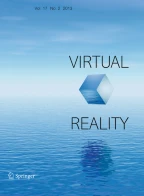Abstract
Spatial collaboration is an everyday activity in which people work together to solve a spatial problem. For example, a group of people will often arrange furniture together or exchange directions with one another. Collaborative virtual environments using desktop PCs are particularly useful for spatial activities when the participants are distributed. This work investigates ways to enhance distributed, collaborative spatial activities. This paper explores how different frames of reference affect spatial collaboration. Specifically, it reports on an experiment that examines different combinations of exocentric and egocentric frames of reference with two users. Tasks involve manipulating an object, where one participant knows the objective (director) and the other performs the interactions (actor). It discusses the advantages and disadvantages of the different combinations for a spatial collaboration task. Findings from this study demonstrate that frames of reference affect collaboration in a variety of ways and simple exocentric-egocentric combinations do not always provide the most usable solution.
Similar content being viewed by others
Explore related subjects
Discover the latest articles, news and stories from top researchers in related subjects.References
Benford S, Reynard G, Greenhalgh C, Snowdon D, Bullock A (2000) A poetry performance in a collaborative virtual environment. IEEE Comp Graph Applic 20(3):66–75
Churchill EF, Snowdon D (1998) Collaborative virtual environments: an introductory review of issues and systems. Virt Real: Res Develop App 3(1):3–15
Dourish P, Bellotti V (1992) Awareness and coordination in shared workspaces. In: Proceedings of ACM Computer Supported Cooperative Work, 107–114
Fraser M, Benford S, Hindmarsh J, Heath C (1999) Supporting awareness and interaction through collaborative virtual interfaces. In: Proceedings of the 12th Annual ACM Symposium on User Interface Software and Technology, Asheville, NC, November 1999
Gutwin C, Greenberg S (1998) Design for individuals, design for groups: tradeoffs between power and workspace awareness. In: Proceedings of Computer Supported Cooperative Work, 207–216
Gutwin C, Greenberg S (1999) The effects of workspace awareness support on the usability of real-time distributed groupware. ACM Trans Comput-Hum Interact 6(3):243–281
Gutwin C, Greenberg S (2002) A descriptive framework of workspace awareness for real-time groupware. J Collab Comput 11(3–4):411–446
Hindmarsh J, Fraser M, Heath C, Benford S, Greenhalgh C (2000) Object-focused interaction In collaborative virtual environments. ACM Trans Comput-Hum Interact 7(4):477–509
Lau LMS, Curson J, Drew R, Drew PM, Leigh C (1999) Use of virtual science park resource rooms to support group work in a learning environment. In: Proceedings of the International ACM SIGGROUP Conference on Supporting Group Work, Phoenix, AZ, November 1999
Leigh J, Johnson AE (1996) Supporting transcontinental collaborative work in persistent virtual environments. IEEE Comput Graph App 16(4):47–51
Leigh J, Johnson AE, DeFanti TA (1996) CALVIN: an Immersimedia design environment utilizing heterogeneous perspectives. In: Proceedings of the IEEE International Conference on Multimedia Computing and Systems, Hiroshima, Japan, June 1996
Leigh J, Johnson AE, Vasilakis CA, DeFanti TA (1996) Multiple-perspective collaborative design in persistent networked virtual environments. In: Proceedings of the IEEE Virtual Reality Annual International Symposium, Santa Clara, CA, 30 March-3 April 1996
Mastaglio TW, Williamson J (1995) User-centered development of a large-scale complex networked virtual environment. In: Proceedings of the Conference on Human Factors and Computing Systems, Denver, CO, May 1995
Schafer WA, Bowman DA (2003) A comparison of traditional and fisheye radar view techniques for spatial collaboration. In: Proceedings of Graphics Interface, 39–46
Stefik M, Bobrow DG, Foster G, Lanning S, Tatar D (1987) WYSIWIS revised: early experiences with multiuser interfaces. ACM Trans Off Info Sys 5(2):147–167
Stoakley R, Conway MJ, Pausch R (1995) Virtual reality on a WIM: interactive worlds in miniature. In: Proceedings of Human Factors and Computer Systems, 265–272
Wickens CD, Prevett TT (1995) Exploring the dimensions of egocentricity in aircraft navigation displays. J Exper Psych Appl 1(2):110–135
Wickens CD (1999) Frames of reference for navigation. In: Gopher D, Koriat A (eds) Attention and performance XVII, MIT Press, Cambridge, MA
Yang H (2002) Multiple perspectives for collaborative navigation in CVE. In: Extended abstracts for the ACM Conference on Human Factors in Computer Systems, Springer, Berlin Heidelberg New York
Yang H, Olson GM (2002) Exploring collaborative navigation: the effect of perspectives on group performance. In: Proceedings of the 4th International Conference on Collaborative Virtual Environments, Bonn, Germany, 30 September-2 October 2002
Author information
Authors and Affiliations
Corresponding author
Rights and permissions
About this article
Cite this article
Schafer, W.A., Bowman, D.A. Evaluating the effects of frame of reference on spatial collaboration using desktop collaborative virtual environments. Virtual Reality 7, 164–174 (2004). https://doi.org/10.1007/s10055-004-0123-3
Received:
Accepted:
Published:
Issue Date:
DOI: https://doi.org/10.1007/s10055-004-0123-3
